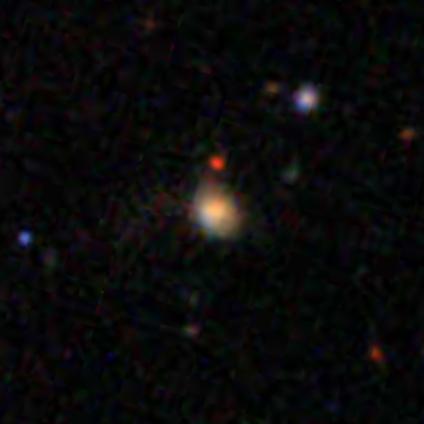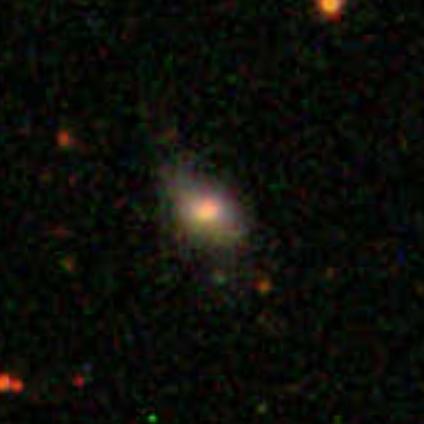Detailed investigation: outliers and anomalies in 'redshift bin #10'
-
 by
JeanTate
by
JeanTate
Before we can start cleaning (see What is needed to get a clean QS and a clean QC?), I think it might be interesting to investigate a somewhat random sample, to see just how many objects - in either catalog - might be outliers or anomalies. That's what this thread is about.
I combined the latest version of the QS and QC catalogs (by downloading them), combined them, and removed all the duplicates.
How to get a 'random sample'?
Well, I could simply generate 100 (say) random numbers in [0,1], multiply them by 5918 (=2*3002-861), and pick the objects with those 100 index values (having ranked the list in some fashion, perhaps even randomly?), making sure to have some 'spares' on hand in case the same index number comes up more than once. That's a good idea, and I might try it later.
What I actually did was sort the 5918 objects by their redshifts, remove the two with 'wrong/highly uncertain' redshifts2, divide the remainder into 24 redshift bins (of equal size=number of objects±1), and choose a bin at random. That's how I came up with 'redshift bin #10'! 😮
The minimum redshift in redshift bin #10 is 0.085967541 ( AGS00004h8), and the maximum is 0.0894129 ( AGS00000qr); there are 116 QS objects in this bin, and 130 QC ones.
Let the detailed investigation begin! 😃
1 3002 is the number of objects in each of QS and QC; 86 is the number of duplicate objects
2 AGS00002ak and AGS00002ds
Posted
-
 by
JeanTate
by
JeanTate
Here are the 130 QC objects, ranked in order of their Petro_R50 ("R50") values (DR10 60x60 image cutouts, scale=0.4):
Posted
-
 by
JeanTate
by
JeanTate
And the 116 QS objects, same ranking (etc):
Posted
-
 by
JeanTate
by
JeanTate
Nothing stands out - to me - as an anomaly in these two sets of images ... except for two:
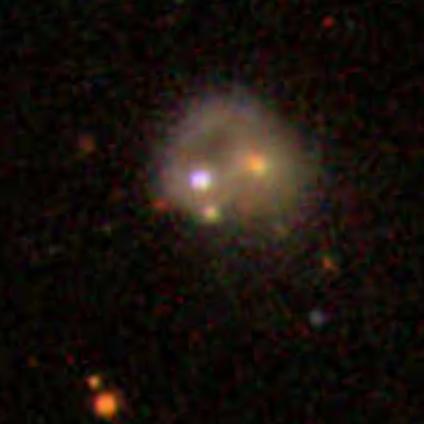
This is AGS00002vf, a QC object, is a merger, with the smallest/faintest of the three obvious 'pieces' of the merger as 'the object'. R50 is given as 6.579" in the catalog, which is the same as the R50 value in DR7. However, this seems to be a failure of the deblender; the main object is surely 587742551211769894:
In DR9, R50 for AGS00002vf is 0.60" (and R90 1.13), and for 587742551211769894, they are 5.85 and 15.59, respectively.
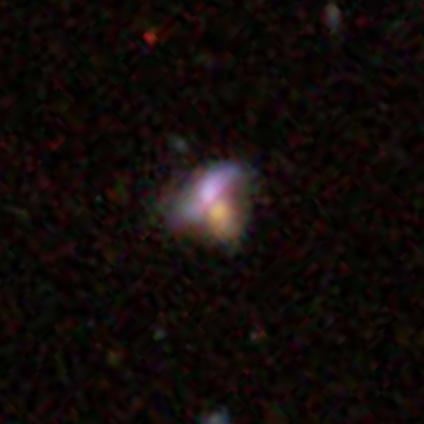
AGS00000n4, a QS object. It too is a (spectacular!) merger. DR7 and DR9 disagree about R50 (and R90) - 3.27±0.15 (7.05±1.0) vs 2.34±0.22 (5.61±1.7), respectively - but not so radically as for AGS00002vf.
Apart from the general question of "what is the 'galaxy' in 'post-quenched galaxy', where it's clearly an unfinished merger?" - for which we really should have a consistent answer, in order to be able to do robust analyses - these images also leave me wondering how good (and how useful!) R50 is, for very long and skinny Eos, especially those with a tiny bulge (or none at all).
Posted
-
 by
JeanTate
by
JeanTate
As
Brooke/vroojeklmasters says, in the First go at exploring data: Colors of quench versus control thread, "really recently starformation shows up in the u-band, while r-band will reveal more mature stars." We don't have images displaying (u-r), but maybe showing the galaxies in redshift bin #10 in (increasing) order of (u-r) will reveal an interesting pattern? Perhaps even some anomalies?Here are the 130 QC objects, sorted in just such a way (DR10 cutouts, 60x60, scale 0.2). AGS00003ov has the lowest (u-r), 1.31, followed by AGS00004a3 and AGS00002nu (1.43). At the other end, AGS0000380's is 3.14, and AGS00004d7's 3.19.
Posted
-
 by
JeanTate
by
JeanTate
Here's the same thing, for the 116 QS objects.
AGS00000jn begins the parade, with (u-r)=1.41, followed by AGS0000024 (1.43) and AGS000017g (1.57). At the other end, (u-r) for AGS00000ao is 3.15, AGS00000ye's is 3.23, and AGS00000f1's is ... wait for it ... 6.84!
Posted
-
 by
JeanTate
by
JeanTate
There's just one object whose (u-r) color seems, well, wild; the QS galaxy AGS00000f1:
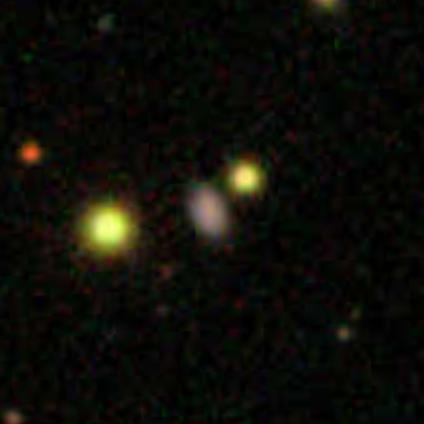
Its enormous (u-z) value (6.84 mags) comes from its extremely faint u-band modelmag - 24.68±2.45 (in DR9 it's 25.13±1.90) - rather than an especially bright r (17.84±0.01). Even at the extreme bright end, the u-band mag is still far to faint to bring this galaxy within range of the others.

Anything else?
Well, have the superior DR10 image processing routines shown that there are foreground stars almost 'on top of' galactic nuclei, in two QS objects?
This galaxy, AGS000006r - NOT anomalous in any way that I can tell! - shows the superiority of the DR10 images:
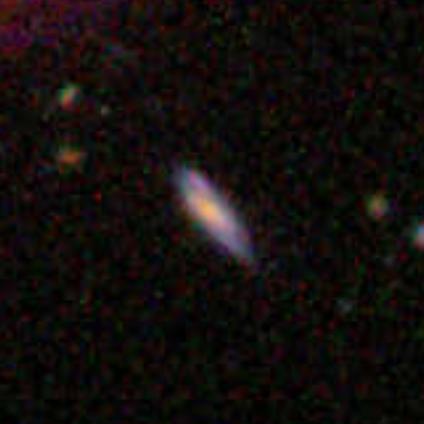
But does it, too, sometimes mislead? Consider AGS00002os; is there a faint foreground star on top of (or a faint galaxy in the background of) the somewhat disturbed barred CW spiral? Or is it just an artifact? Or ...?
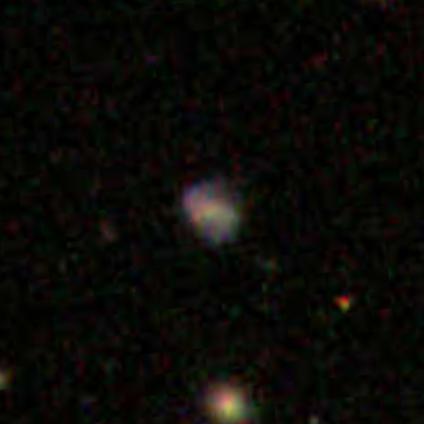
Posted
-
 by
JeanTate
by
JeanTate
This is a check I would not normally even have thought of doing; however, having discovered that the Quench project images do not match the SDSS DR7 ObjIds for 13 QC objects1, I decided to check the SDSS DR7 entries for each of the 246 redshift bin#10 objects, to see if they match what's in the QS and QC catalogs that I downloaded.
This is a fairly simple CasJobs query, so I also downloaded the R50 and R90 values (as well as their errors).
The R50 values match, to ~six significant figures; good.
However, the RA and Dec values rarely do 😮
Here are two examples, the DR9 image you get when you click on the "View on SkyServer" link in the GZ/Quench Examine page, then the DR7 'cross-hairs' one, for the DR7 ObjId; first AGS000013q (588017626682556693):
Next, AGS00001yb (587741387809292832):
What's going on?
I'm not 100% sure, but for these two at least it's a case of the QS/QC catalog values - especially the RA ones - being rounded down too much. Not only on the GZ/Quench Examine page, but also in the downloaded catalog, the RAs have only three significant digits - 154.964 and 119.576 for the two examples above, respectively - but you need at least four, preferably five, to pinpoint the location of the center of the spectroscope's fiber.
But, are there any cases like AGS00001bl (588017726012129327)1, in the redshift bin #10 objects? I'm still checking, and will update this post when I've finished. 😃
UPDATE: it seems it's a lot more complicated than simply too few significant digits. For example, the live link sometimes does strange things. Consider AGS00001xu (587741531719139429; catalog (RA, Dec) = 190.17, 29.0572). When you click the "View on SkyServer" link, you get this (DR7 ObjId 587741531719139429 for comparison):
The URL for the DR9 image says it's centered on "ra=190.17458653&dec=29.05313864"! 😮 So it would seem that the GZ Examine code does something like 'search for the DR9 primary galaxy object closest to these coordinates', and because the coordinates aren't precise enough, it sometimes makes a big mistake.
1 I discovered something similar, in terms of a much less severe mismatch, for AGS00001bl (588017726012129327). This is the DR9 image you get when you click the "View on SkyServer" link in the GZ/Quench Examine page; next to it is the DR7 object 588017726012129327:
This is a complicated case; the nucleus/bulge has no spectrum, but there are two, of two different clumps in the arms. But it's not in bin #10!
Posted
-
 by
JeanTate
in response to JeanTate's comment.
by
JeanTate
in response to JeanTate's comment.
In choosing to work with DR7 ObjIds - and their associated (RA, Dec) coordinates - but to display using the DR9 SkyServer, the GZ Examine tool sometimes gets tripped up ... by inconsistencies between DR7 and DR9! 😮
Take AGS00001xu (DR7 ObjId 587741531719139429). This is what you get when you use DR7 Navigate and enter (190.17, 29.0572) as the location:
The blue circle is a 'photometric object', and the red square an 'object with spectra'1; the RA of AGS00001xu is 190.170417 (to six significant figures), hence the obvious offset between the cross-hairs and the location of the photometric object.
Here's the same thing, using DR9:
DR7 587741531719139429 is still a spectroscopic object (red square), but is no longer a photometric object (no blue circle)! 😮 😮
So it would seem that SkyServer jumps to the closest photometric object, given the (RA, Dec) coordinates, but not the location specified ... the URLs give this game away.
This also explains what happens with AGS00001yb (DR7 ObjId 587741387809292832), above. The lack of precision in RA means that the DR9 SkyServer pointed to a photometric object close to DR7 ObjId 587741387809292832, one without a spectrum (DR7 first):
Does this lead to mismatched objects in the downloaded QS and QC catalogs?
I can certainly come up with a scenario or two where it might, but for redshift bin #10, it seems that the only mismatches are between what the DR9 SkyServer displays and what's actually in the two catalogs.
1 Quite coincidentally, you can see that the fiber covering fraction is high; the blue circle is ~5" in diameter, while the fiber aperture is 3", add in ~1.4" seeing (FWHM), and the spectrum of 587741531719139429 is of light from just a bit smaller than the blue circle
Posted
-
 by
JeanTate
in response to JeanTate's comment.
by
JeanTate
in response to JeanTate's comment.
I just posted this, concerning the redshift bin #10 QS object AGS00000qr, over in the Galaxy Zoo forum (What are the galaxy's ugriz magnitudes?); I'll copy any replies here too:
The galaxy is SDSS J085928.63+455113.2, DR7 ObjId 587731887351857350:
It has several photometric objects as 'neighbors', two of which - 587731887351857353 ("NE1") and 587731887351857351 ("NE2"), both "GALAXY", photometrically speaking - are, most of us would say, simply part of the galaxy itself:
The photometry of 587731887351857350 is, per the SDSS DR7 Explore page, (u, g, r, i, z) = (19.32, 17.38, 16.61, 16.09, 15.77); the (u-r) color is thus 2.71.
That of NE1 is (19.99, 21.78, 22.84, 22.37, 22.81), and its (u-r) color is -2.85.
And NE2 (22.00, 21.93, 21.93, 21.63, 20.78), giving a (u-r) color of 0.07.In SDSS the photometric magnitudes quoted, for galaxies, are modelmags, the output of a part of the pipeline which selects a 'best fit model' for the galaxy, and derives the magnitudes from that model.
As NE1 and NE2 are, almost certainly, part of the main galaxy (and not separate, overlapping, galaxies), I can combine the photometry, to get (18.79, 17.35, 16.60, 16.08, 15.76), and a (u-r) color of 2.19.
Now the g, r, i, and z mags hardly change; the differences are all1 ~the same as the quoted error (0.01, in all four cases). However, the u-band modelmag is quite different, 0.53 mags in fact, which is much greater than the quoted error (0.08). More dramatically, the (u-r) color has gone from 2.71 to 2.19.
What to do?
Work with the main - central, brightest, etc - component alone, and assume that the other pieces are never bright enough (or differ wildly enough, in color) to matter? Perhaps double or triple the quoted errors to CYA?
Diligently track down each
errantstray piece, and add them all back, to get a more realistic photometric picture of the galaxy?Something else?
1 the g-band one is a bit bigger, 0.035
As you might guess, it was AGS00001yb (DR7 ObjId 587741387809292832) that got me thinking about this. While the differences for AGS00001yb are trivial - adding the two smaller pieces (which are, interestingly, both "STAR") makes essentially no difference to any color - I guessed that this would not always be the case. And I checked only two other QS objects (yes, both Eos) before finding AGS00000qr.
Posted
-
 by
JeanTate
in response to JeanTate's comment.
by
JeanTate
in response to JeanTate's comment.
mlpeck replied:
I'd vote for something else, namely use DR8+ data (link goes to DR10 explore, I hope). Note below that a photometric object has been dropped. The photometry for the object coinciding with the spectrum position looks reasonable to me at least.
Posted
-
 by
JeanTate
in response to JeanTate's comment.
by
JeanTate
in response to JeanTate's comment.
What difference does this make, going from DR7 to DR10?
In DR7, the edge-on disk galaxy has (u, g, r, i, z) photometry of (19.32, 17.38, 16.61, 16.09, 15.77), and a (u-z) color of 2.71; in DR10 it is (18.92, 17.35, 16.6, 16.08, 15.75), and a (u-z) color of 2.32. Adding in the photometric object at the NE tip changes the DR10 photometry by amounts that are ~within the stated error bars, and the (u-z) color is almost the same.
At least in this case, the DR10 photometry seems more robust.
Posted
-
 by
JeanTate
in response to JeanTate's comment.
by
JeanTate
in response to JeanTate's comment.
To what extent are the "Yes, this disk galaxy could be edge-on" and "This is a cigar-shaped smooth galaxy" overlapping classifications? If no true elliptical is more elongated than E71, then any 'cigar-shaped' galaxy with an AB2 of <~0.3 must be an edge-on disk galaxy (Eos).
Here are DR10 images (scale=0.2) of all such galaxies; also all 'disk_edge' galaxies. Ranked, in order of the mean r-band AB value.
First, cigar-shaped QC galaxies (all of them); AB ranges from 0.13 to 0.31:
Next, cigar-shaped QS galaxies (all of them); AB ranges from 0.19 to 0.27:
Edge-on QC galaxies (first row), and - in the second row - NOT edge-on disk QC galaxies, with AB values less than or equal to 0.36 (the max such, for the edge-on ones):
Edge-on QS galaxies (first row), and - in the second row - NOT edge-on disk QS galaxies, with AB values less than or equal to 0.32 (the max such, for the edge-on ones):
And finally, two edge-on QS objects, in the first row, whose AB values are 0.34 and 0.55, respectively; in the second row, the two NOT edge-on disk QS galaxies, both with AB values of ~0.55:
OK, not quite ... there are three smooth galaxies, classified as "In between", with AB values of 0.28 (the first one, the only QS), 0.30, and 0.31:
1 In the Hubble classification scheme, an elliptical's 'ellipticity' is quantitative, derived from the ratio of the semi-minor axis length (b) to the semi-major one (a) as follows: 10*(1-b/a). More in this GZ forum thread: What is the relationship between 'ellipticity' and 'axis ratio'?
2 There are at least ten "AB" parameters in the SDSS DR7 PhotoObj table (and errors for each); they are all estimates of the ratio of the semi-minor axis length (b) to the semi-major one (a) ... one for each band, and one for each of the two radial profile models applied ("exponential" and "deVaucouleurs")
Posted
-
 by
jules
moderator
in response to JeanTate's comment.
by
jules
moderator
in response to JeanTate's comment.
Good call Jean! I've been looking at my set of edge on galaxies and wondering the same thing. Looking at your images there doesn't appear to be a clear distinction between the 2 categories. Hope a scientist drops by to answer this one.
Posted
-
 by
mlpeck
by
mlpeck
I'm not sure I understand a few points. Are the NOT edge on galaxies ones that the GZ classifiers decided weren't edge on but the SDSS photo pipeline estimated a low value of the ratio a/b?
I had a personal rule for classifying. Any time I was tempted to call something smooth and cigar shaped I picked edge on disk instead.
I wonder why both options were even offered. I suppose edge on lenticulars could be seen as smooth and cigar shaped, but I expect real lenticulars are scattered among several classifications.
Posted
-
 by
JeanTate
in response to jules's comment.
by
JeanTate
in response to jules's comment.
I think it's a bit more complicated than that.
The FIRST classification question - "Is the galaxy simply smooth and rounded with no sign of a disk?" - concerns smoothness and roundedness, so an elongated object which is smooth (and rounded 😉) gets the 'Smooth' vote. At the next question - "How rounded is it?" - you don't get a chance to say if you think it could be an edge-on object. While you and I (and mlpeck!) might agree that most, possibly all, the 'cigar-shaped' objects here do have features, we'd be being a bit unfair ... these are DR10 images, not the DR8/9 ones served up in Phase 1 (I'll have a go at posting these 14 objects - and the edge-on ones too - as they appear in DR8/9, later).
Perhaps more interesting - to me anyway - is that 'rounded' does not include 'having pointy ends' 😃 And several of the 'cigar-shaped' galaxies seem, to me, to have pointy ends (again, though, based on DR10 images).
On the other hand, I think all the objects classified as edge-on do have features ... if you also allow that 'being extremely thin and skinny' is a 'sign of a disk' 😉
Finally, this is just one, very narrow, redshift range; I expect that the mapping of zooite classifications to Hubble type (or similar) may be different in different redshift ranges (or, somewhat similar, different size-on-the-sky ranges).
I don't think this matters much, in terms of analysis - there are other criteria we can use to say whether an object is more likely to be and ETG than a disk with on-going star-formation (or similar) - as long as there are no apparent systematic differences between QS classifications and QC ones ... a key advantage of having each QS object paired with a QC one is that it greatly reduces the scope of systematic effects!
Posted
-
 by
JeanTate
in response to mlpeck's comment.
by
JeanTate
in response to mlpeck's comment.
Are the NOT edge on galaxies ones that the GZ classifiers decided weren't edge on but the SDSS photo pipeline estimated a low value of the ratio a/b?
Yes.
I wonder why both options were even offered.
It's a good question; I think there may have been an expectation that E6 and E7 galaxies would classified as 'cigar-shaped', and that most zooites - like you - would have selected 'features or disk' for highly inclined disk galaxies, even if they appeared smooth (and rounded).
Posted
-
 by
JeanTate
in response to mlpeck's comment.
by
JeanTate
in response to mlpeck's comment.
I'll have a go at posting these 14 objects - and the edge-on ones too - as they appear in DR8/9, later
Here are the QC cigar-shaped galaxies, in the same order as in my earlier post, with the same size (120x120) and scale (0.2), but from DR9 (first row), with the corresponding DR10 image immediately below:
And the QS cigar-shaped galaxies (same deal); for the last one, the DR10 image is next to (rather than under) the DR9 one:
And the QC edge-on disk galaxies (DR9 images, then DR10 ones):
The first five QS edge-on disk galaxies:
And the last two (I made the field bigger for the last one, to try to understand why it was classified 'edge-on'):
Posted
-
 by
JeanTate
by
JeanTate
AGS00001x8 (DR7 587741601492238440), a QS object, has a u-band modelmag of 20.12±0.11. Adding that of the photometric object which is clearly part of the galaxy itself, the u-band modelmag becomes 19.69. In DR10, there's just one photometric object, and it has a u-band model mag of 19.83±0.09.
Posted
